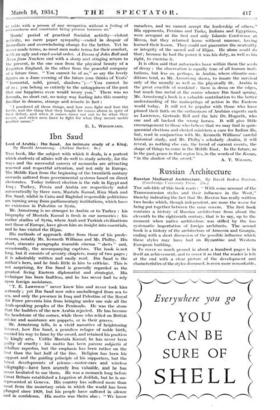Russian Architecture
Russian Mediaeval Architecture. By David Roden Buxton. (Cambridge University Press. 25s.) THE sub-title of this book reads : " With some account of the Transcaucasian styles and their influence in the West," thereby indicating the fact that Mr. Buxton has really written two books which, though independent,. arc none the worse for being put together between the same covers. The first book contains a history of Russian architecture from about the eleventh to the eighteenth century, that is to say, up to the moment when native architecture was stifled. by the too systematic importation of foreign architects. The second book is a history of the architecture of Armenia and Georgia, ending with a short discussion of the possible influence which these styles may have had on Byzantine and Western European building.
To cover so much ground in about a hundred pages is in itself an achievement, and to cover it so that the reader is left at the end with a clear picture of the development and characteristics of the styles discussed, is even more remarkable.
Mr. Buxton manages this by the extraordinary simplicity of his style, which seems to be designed only to convey his exact- Meaning in its clearest form. There are no ornaments to ,Obscure the matter, no digressions to distract the reader ; the ideas follow as easily and as regularly as the lines on the page: And the ideas themselves are no less good than their method Of presentation. The book exudes that particular atmosphere which suggests that, whatever the author may have learnt front- the work of others has been thoroughly absorbed and used only as material for presenting a perfectly' personal Point of view. The fact that nearly all the plates are from the author's own photographs proves that he has not taken his architecture at second hand, and his real enthusiasm for his subject is evident in every page.
In dealing with Russian architecture Mr. Buxton considers :separately the different. districts in which • it flourished, analysing the factors which made it vary from place to place. These factors arc of all kinds—political, geographical, religious and structural - but among the most interesting is the influence of the wooden architecture of North Russia on the brick style of Moscow. Many details invented to sol;re the problem of building in wood were transferred to the brick style, where they remained as non-structural but decorative features. These qualities in Russian -architecture are relevant to the question which Mr. Buxton asks in discussing certain types of Georgian decoration, namely : ." Is there any abstract reason for subordinating ornament to structural mechanics, for making of decoration something integral, expressive of structure, rather than something extraneous which ignores it ? " It is pleasant and surprising to find at any rate an implied affirmative answer to this question from one who is evidently not an admirer of the Baroque, the style with which the non-structural view of ornament is generally associated.
Mr. Buxton is no less successful in writing of Armenia and Georgia than of Russia, and his summary of the various Mews held about the possible influence of the architecture 'of these countries on western Europe is clear and useful. We can only regret that he did not discuss further an inter- esting influence of purely Russian architecture on that of the west, in the matter of the origin and spread of the bulbous
dome. Mr. -Buxton shows conclusively that this dome is Russian in origin, and suggests, plausibly enough, that it was evolved, probably about the twelfth century, as the best type of dome for throwing off snow in the winter. This theory is to some extent confirmed by the distribution of the bulbous dome in Central Europe, where it is particularly connected, in its pure onion form, with the mountainous districts of Shuth Bavaria and Austria, though it was used in a more decorative and less practical form all over the South of Germany and the whole of Austria. The history of its introduction into Central Europe is obscure, but it had certainly reached Munich -by the early sixteenth century, when the towers of the Frauenkirche were given the domes which now cover them. In the seventeenth century it became habitual and it seems impossible to attribute to anything but Russian influence churches like Kappel in the Upper Palatinate with- its three round towers capped with onion domes, Maria Birnbaum with its three members covered with ogee domes, and, above all, Westerndorf, near Rosen- helm, in which the whole building of quatrefoil plan is enclosed under a single purely Russian bulbous dome. On the other hand it looks as though the particular form of dome popular in Ukraine and used in the cathedral at Kiev might be a Central Europeangilibilification of the onion borrowed back by the Russians, perhaps front Bohemia via Poland.
Finally it must be said that the Cambridge University Press has produced the book superbly. The plates arc plentiful and adMirably clear, and they have been chosen so as to illustrate directly each point- made in the text. There are many useful diagrams and plans, two necessary maps and a well annotated bibliography.
ANTHONY BLUNT.











































 Previous page
Previous page